2. Retro Computers
Apple
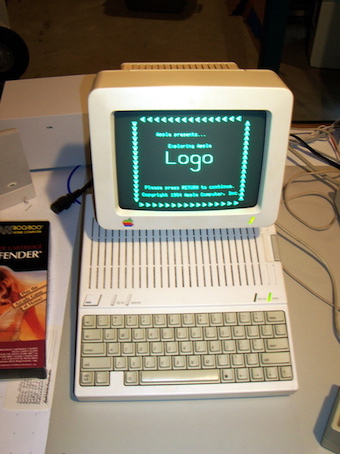
Apple Computer was founded by Steve Wozniak and Steve Jobs in 1976. Steve Wozniak provided the technical genius for computer creation, while Steve Jobs provided the expertise in marketing and design. Their first major commercially adopted product was the Apple II in 1977, which had a MOS 6502 CPU (also used in Commodore computers such as the Commodore 64) and shipped with BASIC and the DOS operating system (later versions). The Apple II was very well built and had tons of expansion ports. It inspired thousands of people to enter the computer world. Thousands of programs were made for it, and it made its way into nearly every industry in a short period of time. The famous spreadsheet, Visicalc, made the Apple II a great business tool, its ease of use made it extremely popular in the school system (every school I went to had them, even in the 1990s), and its BASIC interpreter and easy expandability made it famous with hackers, engineers and scientists (the first demonstration of public key cryptography was hacked together by a few mathematicians on an Apple II).
The Apple II was revised many times; my favorite Apple II model was the compact and powerful Apple IIc that came with 128K of RAM. My Apple IIc shown to the right is running the LOGO programming tools. Because of its insane popularity, the Apple II was still sold for almost a decade after the Macintosh was introduced. Although the Apple II competed directly with Atari, Commodore, and Tandy, it was widely seen as the “better made” computer. They still run well today amongst the Apple II hobbyist community due to the high quality of their manufacturing.
After viewing the latest graphical technology at the Palo Alto Research Center (PARC), Apple Computer focused much of its research and development on creating a computer that had a Graphical User Interface (GUI). The first attempt at this was the Apple Lisa in 1983 (later renamed the Macintosh XL), which used the advanced Motorola 68000 CPU (used in many computers in the 1980s including the Commodore Amiga). Due to its high cost ($10,000 US) and sparse software support, the Lisa failed to sell in large numbers. During the creation of the Apple Lisa, Steve Jobs led a secret research team off company premises that eventually led to the creation of the Macintosh computer in 1984.

In addition to having a faster Motorola 68000 CPU than the Apple Lisa, the Macintosh shipped with the Macintosh OS, which used an advanced GUI that is very similar to the graphical interfaces used on modern computers today.
Shown to the left is my Mac rack - every model of classic Macintosh including the original Mac 128K (I have one of the first, made in Feb 1984), Mac 512K (called the “fat mac”), Mac Plus, Mac SE, Mac SE/30, Mac Classic, Mac Classic II and Mac Color Classic. I also have all Mac OS system software from System 1 to 7 (the trick is to use an external SCSI drive with a Mac Plus to build the floppies for older Macs that only support 400K disks).
Since Steve Jobs considered each Mac a “work of art”, if you open up a Mac, you will find the signatures of each person who worked on the Mac team inscribed into the inside of the case as shown in the picture below (from a Mac 512K):
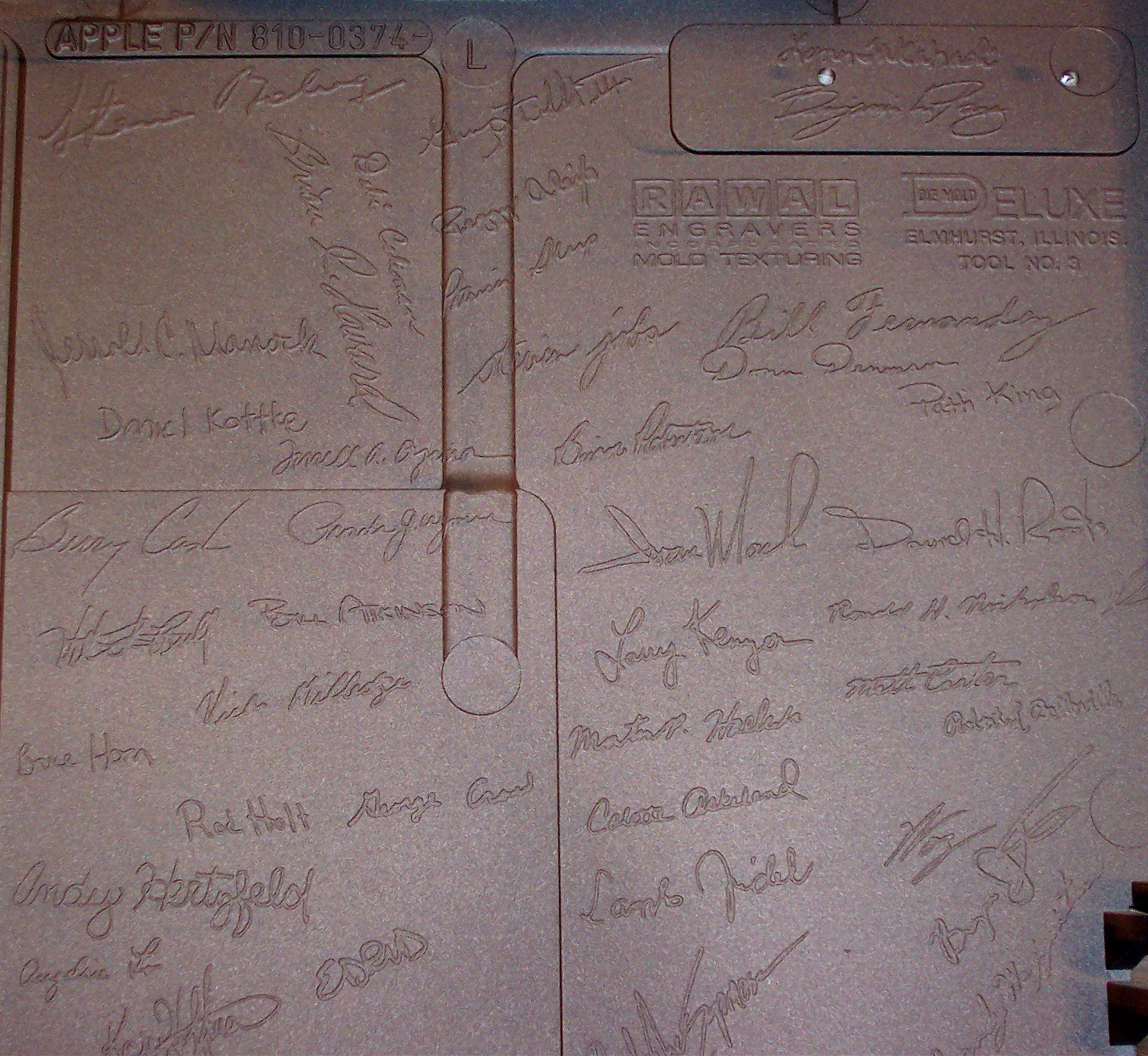

Apple led the charge when it came to innovation, and Macintosh laptops were the first widely used portable computers in the early 1990s. To the right is a picture of my PowerBook 540c laptop, which was the first series of laptop to introduce the trackpad (now called the touchpad). But more importantly, the PowerBook 540c was the laptop used in the famous movie Hackers in 1995 in the scene at the end of the movie when they were hacking the Gibson supercomputer.
In the same movie, they used another Macintosh laptop during the party scene at Acid Burn’s house. This was the scene where the hackers were checking out Burn’s laptop, which was apparently “top-of-the-line” at the time with a P6 chip and an awesome refresh rate. However, the laptop wasn’t a PC laptop, it was a prototype PowerBook 2300c that had a PowerPC CPU (one of the first Mac laptops that shipped with a PowerPC CPU).
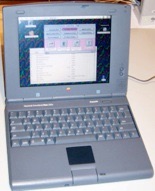
The picture on the left is one of my PowerBook 2300c laptops. The only difference between this one and the one in the Hackers movie is that they erased the Apple logo and model name from the case.
Apple was also the first to market a PDA (Personal Digital Assistant): the Apple Newton MessagePad. Released in 1993, it had an ARM RISC processor, its own OS, lots of programs, networking ability, a stylus and handwriting recognition.
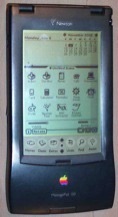
Unfortunately, it was well before its time and didn’t sell well. It was eventually discontinued in 1998. Shortly thereafter, Palm was formed by some of the people from the Newton project who left Apple (which was the right timing for a PDA, around year 2000). The Newton MessagePad you see to the right still holds my contacts and daily schedule (works great!). Although it was a flop, the Newton returned in all of its glory over 10 years later as the iPad ;-)
As Apple Computer grew, both Steve Jobs and Steve Wozniak left the company to pursue other ventures. Steve Jobs created the NeXT computer company and bought the Pixar computer animation company for which he served as CEO until 2006 when Pixar was bought by the Walt Disney company. When Apple was in financial trouble in the mid-1990s, Steve Jobs returned to the company as CEO (still retaining the CEO position at Pixar, and selling NeXT to Apple). With his motivational and innovative guidance, Apple Computer became profitable again with the release of iMac computers based on the IBM PowerPC G3 CPU. However, Macintosh computers still ran an operating system that looked very much like the original Macintosh OS (the latest version of this operating system is called Macintosh OS 9).
Apple seriously needed a new OS that didn’t suck, and fast! which is where the NeXT acquisition came into play. Apple slapped a new desktop look on top of the powerful NeXTSTEP UNIX-based OS and called it Mac OS X (or Mac OS 10.1). Although Mac OS X wasn’t released until 2001, it didn’t take users and application developers long to realize how great of an operating system it was alongside newer Macintosh computers that ran modern IBM PowerPC G4 and G5 CPUs. In 2006, Apple switched its Macintosh CPU to the Intel platform once Intel released the Core 2 Duo (running Macintosh OS X 10.4). Apple has since renamed Mac OS X to simply macOS. Unfortunately, since about 2015, Apple has been systematically locking down the open UNIX nature of macOS to make it more like an iPad running iOS. With macOS Catalina, there’s very little you can do with it outside of the restrictive Apple ecosystem, and with the upcoming macOS Big Suck (um, I mean Big Sur), macOS is basically iOS.
Commodore
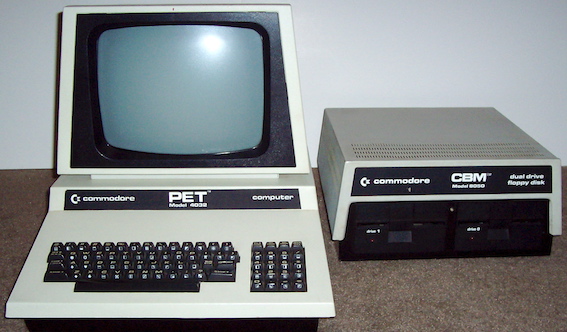
Commodore was one of the earliest and best-known computer manufacturers of the 1970s and 1980s. I don’t think you could find anyone who didn’t recognize the Commodore logo (even if they were not computer literate). This was mainly due to the fact that Commodore made “computers for the masses” - the average person could actually afford one! Although Commodore started by manufacturing programmable business calculators, they entered the computing market by storm with their Commodore PET (Personal Electronic Transactor) monochrome computer in 1977. The Commodore PET used the MOS 6502 CPU (Commodore bought MOS shortly beforehand). Since it was an all-in-one computer, it was an instant hit with schools across North America. The right picture is my Commodore PET 4032 with 32KB of RAM, Commodore BASIC OS in ROM, and a dual floppy disk drive unit (500KB per floppy).
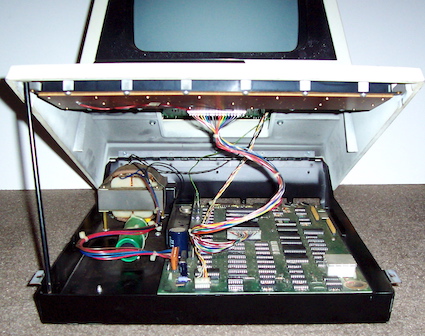
The best thing about the Commodore PET was its accessibility - you could flip up the whole computer top like a car hood (it even had a retractable metal stick to hold it up like a car hood has). The internal components were laid out in a simple yet beautiful manner (as shown to the left). The power supply was bolted to the bottom of the computer on the left, and the motherboard was laid flat on the bottom of the computer, with cables that ran to the power supply, keyboard and monitor.
Although the Commodore PET did very well in schools, it wasn’t a huge success in the home market due to cost. As a result, Commodore took their success from the Commodore PET and applied it to the Commodore VIC 20.
The Commodore VIC 20 (Video Interface Chip 20) from 1980 was the first cheap home computer that could plug into your TV, and the first computer to sell 1 million units. It only had 5KB of RAM (3.5KB was usable by programs), a MOS 6502 CPU, support for 16 colours, Commodore BASIC OS in ROM, and an optional external tape drive that you could load additional software from or save programs to. Because of the huge commercial popularity of the VIC 20, Commodore released the Commodore 64 a year later with 64KB of RAM, MOS 6510 CPU, a monitor and a high quality external disk drive that was probably the most reliable floppy disk drive ever created - the Commodore 1541.
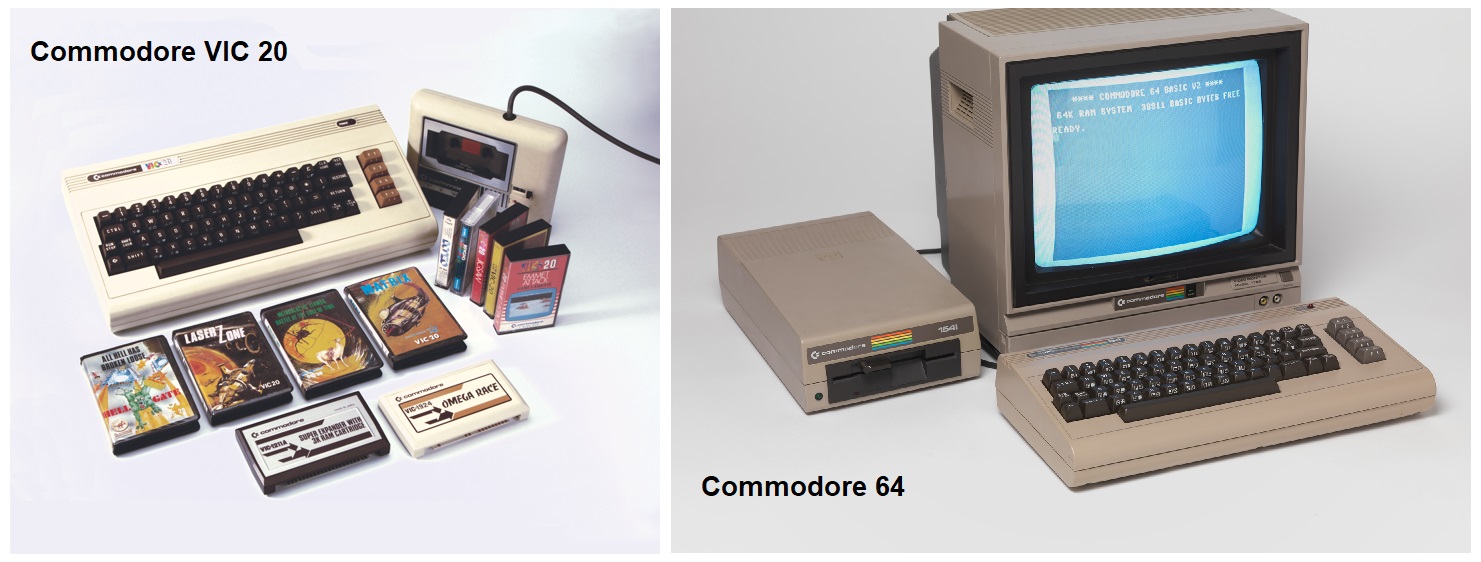
Although my school had several Apple II computers in our library, it had a whole lab room full of Commodore 64 computers on movable carts (so that they could be wheeled from class to class). I spent most of my time on the Commodore 64 in school, and was most comfortable with it as a result. The expression LOAD ”*”,8,1 still brings back fond memories for me (this command loads all programs from the first external floppy disk drive into raw memory). Most people who had a computer in the 1980s had a Commodore 64. You could even buy a Commodore 64 and all of the extras at the local Canadian Tire store. Better yet, it you found computer software in a store, chances were that it was for the Commodore 64 (a somewhat distant second would be the Apple II). Although it was more expensive than the VIC-20, the Commodore 64 was the most common because its hardware was amazing - it was the most advanced personal computer on the market at the time. And more importantly, it still holds the record of the best selling computer of all time (17 million units).

Commodore also released a portable version of the Commodore 64 called the Commodore SX-64 (I actually still use mine today to play games). It was identical to the Commodore 64 hardware-wise, but came in a cool metal case with a detachable keyboard, built-in 1541 drive and 5” colour display. In fact, the Commodore SX-64 holds the distinction of being the world’s first colour portable computer.
The Commodore 64 was so great, that Commodore still manufactured it well into the 1990s. But, while the Commodore 64 was Commodore’s best-selling and longest-lived computer, it certainly wasn’t Commodore’s best 8-bit computer - the Commodore 128 was.
For Christmas one year, my parents bought the family a Commodore 128, which was far more powerful than the Commodore 64, and most-importantly was also software-compatible to the Commodore 64 (which still had the largest software library of any computer at the time). It could use the same 1541 floppy disk drive (as well as a faster 1571 floppy disk drive), and shipped with Commodore BASIC, 128K of RAM, a MOS 8502 processor, as well as a second processor (Zilog Z80A) that was Intel-compatible and could run the DOS-like CP/M operating system.
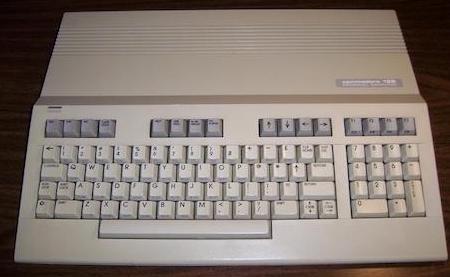
As you can see from the picture to the left, the Commodore 128 keyboard was far more advanced than the “clunky” Commodore 64 keyboard (and hence much better for the word processing that I mainly used it for).
The Commodore 64 and 128 could also run a graphical OS called GEOS (from Geoworks), which resembled the early Mac OS.
At its peak, GEOS was the third most popular operating system in the world in terms of units shipped, trailing only MS-DOS and Mac OS. You can now get it as freeware for Apple, Commodore and NintendoDS.
The Commodore 128 was the last of the 8-bit computers that Commodore made - by the late 1980s, Commodore ended up producing 16/32-bit computers like everyone else in the industry called the Amiga. Unlike its predecessors, the Amiga didn’t run BASIC. Instead it ran its own AmigaOS, which was the first preemptive multitasking OS made for home computers and quite advanced for its time. It consisted of a Kickstart program loaded from ROM (the equivalent of a boot loader and OS kernel in modern operating systems) as well as a set of extra programs that provided a useful interface (called the Workbench) that were loaded from disk (floppy or hard disk).
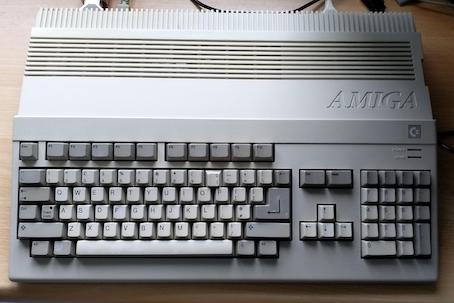
The Amiga used the Motorola 68000 processor (the same used in the much more expensive Macintosh of the time) and had dedicated video and sound processors which made it ideal for multimedia use. In fact, Amigas were used to render the graphics for the television series Babylon 5, as well as to create the pre-visualization effects for the movie Jurassic Park.
Although Amigas didn’t sell well in the home market, the most common version was the home-style Amiga 500 as shown to the left. It looked strikingly similar to the Commodore 128, but had an Amiga logo etched into the right side of the case and was much thicker. It also had a floppy drive built into the right-hand side of the computer that was used to load the AmigaOS Workbench.
The first “professional” Amiga was the Amiga 2000HD, which typically had a few hard drives, floppy drives and an optical drive (which was rare for computers at the time). My Amiga 2000HD shown below doesn’t resemble previous Commodore computers - it has a full PC-style case and is packed with tons of expansion cards. The largest and most popular card is the video toaster card, which combines hardware and software together to perform high-end video processing.
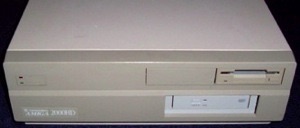
Unfortunately, Commodore’s market was in trouble during the late 1980s and early 1990s due to strong competition from the PC market, and they never regained their market share.
In the early 1990s, Commodore computers ceased to be used as mainstream computers. I heard that Amigas were still common in Europe, but as a niche market.
By 1994, Commodore was bankrupt - however, the brand was later bought in 2005 and briefly revived to sell Commodore-branded PCs (that company is now defunct as well).
Tandy
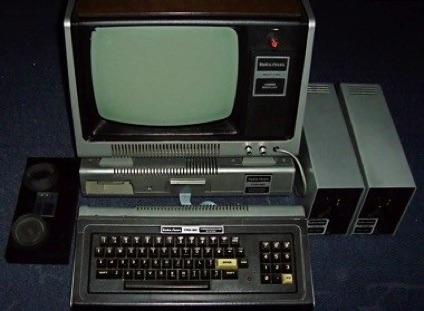
Tandy is best known for its RadioShack stores across North America. However, Tandy also played a major part in the personal computer revolution alongside Apple and Commodore as they released one of the top-selling computers of all time: the TRS-80 (Tandy RadioShack-80). The TRS-80 Model I (shown right) had a Zilog Z80 CPU and 16KB of RAM. Compared to its counterparts of the time, it was well accepted by both business and computer hobbyists, even though it had a cheap build quality and poor software ecosystem (it was given the affectionate nickname “Trash 80”). For an operating system, it ran either TinyBASIC or Microsoft BASIC. If you bought the extra drive controller and disk drives (also shown below), you could instead run TRS-DOS (which was similar to MSDOS).
The device to the left of the computer in the picture of the TRS-80 Model 1 shown above was an early modem. To make a call across a telephone line, you simply put your normal telephone receiver on the two round rubber mounts and the signals beeped through the telephone as if someone was actually using it. When I show people this, they usually think it is pretty neat today. However, a fast link back then was 300 BAUD (you could download a picture in a day).
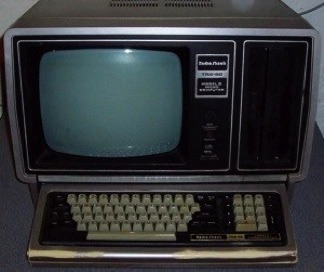
The only problem with most models in the TRS-80 line is that they produced a large amount of RF interference, and the FCC eventually forced Tandy to stop production on certain models. Regardless, the TRS-80 was so popular that Tandy released several variants of it.
The TRS-80 Model II (shown to the left) was specifically geared towards business and had a Zilog Z80A CPU that was twice as fast as the Model I, 32KB of RAM and an 8-inch floppy disk drive in the main unit.
Unfortunately, the amount of software available for the TRS-80 Model II was far less than for the Model I because it ran a newer version of TRS-DOS that was not backwards compatible with the Model I. The best part of the TRS-80 Model II was that you could get an upgrade board for it that turned it into a TRS-80 Model 16 with a Motorola 68000 32-bit CPU that could run Xenix (Microsoft UNIX). Xenix quickly became the main operating system used for the Motorola 68000-based TRS-80 models, and it performed very well on the TRS-80 hardware.
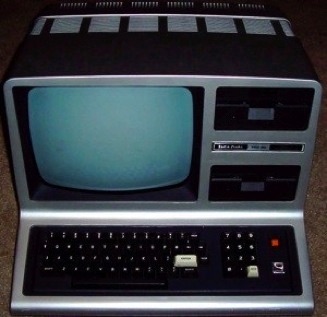
Probably the most impressive model that Tandy ever made was the TRS-80 Model III (shown to the right). The TRS-80 Model III was beautifully designed inside and out and was much better made than previous Tandy models. Although it had a Zilog Z80 CPU that was slower than the Z80A in the TRS-80 Model II, it had dual 5.25-inch floppy drives and an integrated keyboard. Plus, the TRS-80 Model III did not generate the RF interference that the Model I generated.
The TRS-80 models mentioned above were primarily used in business and by advanced users and hobbyists. The first TRS-80 computer commonly used within the home market was the TRS-80 CoCo (Color Computer).
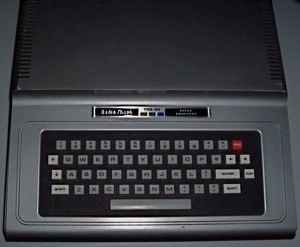
Unlike its predecessors, the TRS-80 CoCo had a Motorola 6809E CPU and colour video chip. The first TRS-80 CoCo model (shown below) had 4KB of RAM and a “chiclet keyboard.” It competed directly against the Commodore, Atari and Apple computers of the time and had a “reasonable” software library to choose from including several games and educational software. The main OS for the Tandy CoCo was Microsoft BASIC, but it could also run the UNIX-like OS-9 operating system.
The Tandy line also contained many other later models; two of the most common lines were the widely popular TRS-80 Model 100/200 portable computer with a Zilog-compatible CPU that ran a custom BASIC OS designed for word processing, and the Tandy 1000+, which had an Intel 8088/8086 or later CPU that ran the ultra-popular MS-DOS operating system. Tandy dabbled in the PC market briefly before succumbing to it. One of the most popular “first” computers that people bought was the Tandy 1000 from their neighbourhood Radio Shack store.
IBM
IBM needs no introduction. Known as “big blue” and the dominator of the mainframe computer market for the 1960s and 1970s, IBM was a hit by reputation alone when it entered the PC market in the early 1980s. As a general rule of thumb, it was safe to buy IBM computers in any company. We had this saying “Nobody ever got fired for buying IBM.”
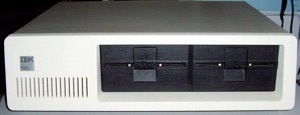
And in fine mainframe tradition, IBM’s PC 5150 (shown to the right) was actually one of the nicest computers of all time. It had an Intel 8088 CPU and 640KB or RAM (16KB on the motherboard and the rest on expansion cards). In addition, it had a sturdy, well-built case that was very aesthetic (even for today), the internal components were very well-made, and the component layout was beautiful (see below). I still consider it today as the most solid PC ever made!
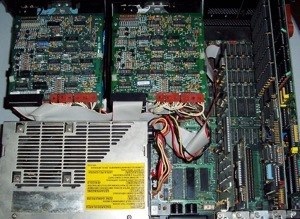
And yes, it ran the MS-DOS operating system, which, by virtue of IBM, became the standard OS used on PCs in the 1980s and early 1990s. DOS was OK, not great, just OK. Everyone knew DOS because it was the standard - I guess you could say that they knew their A:\ B:\ C:\‘s. If you ever needed help with DOS, you could probably find someone close by who has used it. I learned DOS early on (and enjoyed it), and when the game market shifted focus from Apple and Commodore to IBM PCs in the early 1990s, I found myself mastering DOS to execute my favourite games such as Wolfenstein 3D (whofaffa!).

The IBM PC 5150 was an immediate success in business market, but was rare in the home market due to its high cost (over $5000 for the full model) compared to other home PCs at the time such as the TRS-80, Apple II, and Commodore VIC-20. As a result, IBM released the IBM PCjr shortly after. Although the PCjr had the same CPU as the IBM 5150, it ran slower because it lacked a memory controller and only had a maximum of 128KB of RAM. These problems plus some more that led to incompatibilities between other PCs eventually led to its commercial flop. The IBM PCjr shown to the right has the expansion deck at the top that adds another floppy disk and more RAM. The two cartridges inserted at the bottom have Microsoft BASIC and Lotus 123. Although the IBM PCjr was a commercial flop, the IBM PC 5150 was not, and eventually led to several other vendors releasing low-cost IBM PC clones that could run the same software (MS-DOS). By the early 1990s, IBM PC clones were everywhere (from companies such as Gateway, Compaq, Dell, HP, and Twinhead) and so was MS-DOS (as well as DOS clones such as Novell DOS) and the Windows 3.1 window manager program that ran on top of it. Needless to say, the adoption of IBM PC clones accelerated during the 1990s and skyrocketed when Windows 95 was released and everyone wanted on the Internet. By that time, the word “PC” referred to “IBM PC” or “IBM PC clone”, whereas any other computer was called by its brand name only. For example, you had an “Apple Mac” instead of a “PC”, or you had a “Commodore Amiga” instead of a “PC”, although all computers of the time were technically PCs (Personal Computers). Unfortunately, this distinction is still alive and well when it comes to “Windows PCs” versus “Apple Macs.”
Atari
Whenever I think of early computing, I always find myself thinking about video games. I spent a great deal of time in my youth in video game arcades and playing home games on an Atari 2600 VCS game console with friends. Video games were a popular part of growing up back in the 1970s and 1980s and the development of personal computers was closely intertwined with the development of video games. Although the Atari 2600 isn’t a typical computer because it doesn’t have a keyboard or OS, its hardware says otherwise (hence its name, Atari 2600 VCS, or Video Computer System). The Atari 2600 technically was a computer, with a modified MOS 6502 processor.
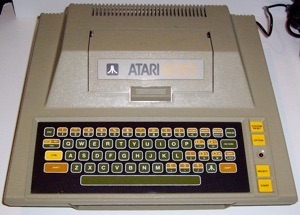
However, Atari also came out with real, multipurpose computers in the 1970s and 1980s; the most famous was the Atari 400 shown to the right. It was basically a fully-featured MOS 6502 computer. Notice that the Atari 400 had a latch at the top that opened such that you can insert a program cartridge such as Pac-man or Atari BASIC (the main OS used on the Atari 400). You could also load programs using an external tape drive, which was fairly unreliable, and the reason why cartridges were so common. And in fine tradition, the #1 use for the Atari 400 was to play video games, and the video games released for the Atari 400 looked very close to their arcade counterparts!
Atari also made several other computer models based on the same MOS 6502 processor to compete directly with the Commodore 64 - the Atari 600, 800, 1200, and XE (and their variants). They also made a high-end Atari ST computer based on the Motorola 68000 CPU to compete with Apple Macintosh and Commodore Amiga as well as a graphical DOS OS called TOS/GDOS. Anyone could tell that Atari was primarily focused on gaming instead of computing due to the abundance of games, and lack of business software and peripherals (especially in later models). The Atari ST was commonly used by musicians for a while (MIDI) in the late 1980s, but Atari computers never really caught on and were pretty much extinct by the early 1990s. However, the Atari brand is still one of the most recognized out there.
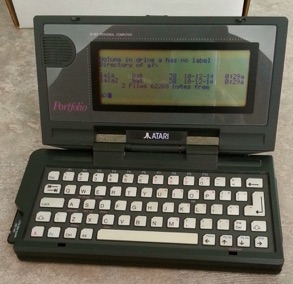
Atari also released the first palmtop computer: the Atari Portfolio in 1989 (shown left). It was essentially an IBM-compatible PC with an Intel 8088 CPU running DIP-DOS.
It runs on 3 AA batteries, and uses Flash storage for everything other than the DOS operating system and some included applications (word processor, spreadsheet, etc.) which are loaded from ROM. It has an expansion port for serial and parallel connections (including modems), and you can insert PCMCIA cards that allow for extra storage (each card has a replaceable lithium watch battery that keeps the information on the card).
One of the most unique features it has is the Atari button, which is used to access applications and menus within applications.
But perhaps the coolest part of the Atari Portfolio is that it was used by John Connor in the movie Terminator 2 to break into an ATM ;-)
Sinclair
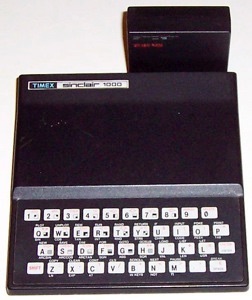
The smallest computer that I wish to mention here is the Sinclair (marketed in Europe as the Sinclair ZX-81 and in North America as the Timex Sinclair 1000). It had a small touch keypad, Zilog Z80 processor, 1 or 2KB of RAM, and an embedded Sinclair BASIC interpreter.
Unfortunately it was a horribly slow computer to use because of RAM limitations. My Sinclair (shown to the right) had the optional 16KB RAM expansion pack (the vertical cartridge at the back of the unit), which made the system much more usable and allowed you to play some pretty cool games.
Few people I knew actually purchased one, so why mention it? Simply put, the Sinclair was the affordable computer of the early 1980s. It sold for under $100US (without the 16 KB expansion pack), almost fit into your pocket, and proved that computing was available for anyone (with any budget). Also, if you watch the British television series “The IT Crowd”, you will see one used in episode #1.
Sinclair eventually released the Sinclair ZX Spectrum computer, which was a color version of the ZX-81 as well as the Sinclair QL, which was a much more powerful yet short-lived system with a Motorola 68000 CPU and 128KB of RAM. However, these computers never caught on in North America, and were extinct by 1990.
ColecoVision
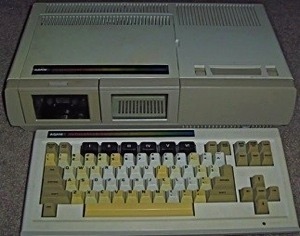
Another computer worth mentioning is the ColecoVision Adam. After the success of the ColecoVision game system, Coleco decided to introduce a computer that had roughly the same specifications as the ColecoVision: a fast Zilog Z80 CPU as well as three Motorola 6801 CPUs for I/O control and 80KB of RAM (16KB was for programs and 16KB was for video).
It shipped with an integrated office suite and had tape drives built into the computer itself. At introduction, the ColecoVision Adam had a large software library already and could run BASIC (compatible with Apple BASIC) or CP/M OS (common at the time). However, it was a commercial flop mainly because it initially lacked a disk drive, the Commodore 64 beat its high price, and the unit developed a large amount of RF interference (you couldn’t put a tape beside the unit while it was on without erasing it). Coleco lost a lot of money on returns due to the RF problem, which ultimately contributed to Coleco’s bankruptcy in 1988. Regardless, the ColecoVision Adam wasn’t bad for the time and the only computer to use roman numerals (the black keys).
Osborne

The Osborne Computer Corporation (OCC) was founded in 1980 by Adam Osborne and aimed to develop portable computers. They released the first portable computer (the Osborne 1) in 1981 and sales went through the roof!
Although the Osborne 1 only had a 5-inch display, it had two 5.25” floppy-disk drives, a 4MHz Zilog Z80 CPU, 64K of RAM and ran the CP/M operating system. It was also bundled with tons of great software such as WordStar and SuperCalc - this software was worth more at the time than the computer hardware itself if you compared it to the other commercial software products available at the time.
What made the Osborne 1 hardware better than its competitors was its packaging - it was packaged in a very well designed case that was both elegant and quite easy to carry (see the picture above). The whole case was designed to be used without a support stand (it was angled already), and when you unlatched the front, the keyboard tray gracefully came off to rest in front of the computer, exposing the ports, which were conveniently located at the front of the computer only (as shown in the picture below).
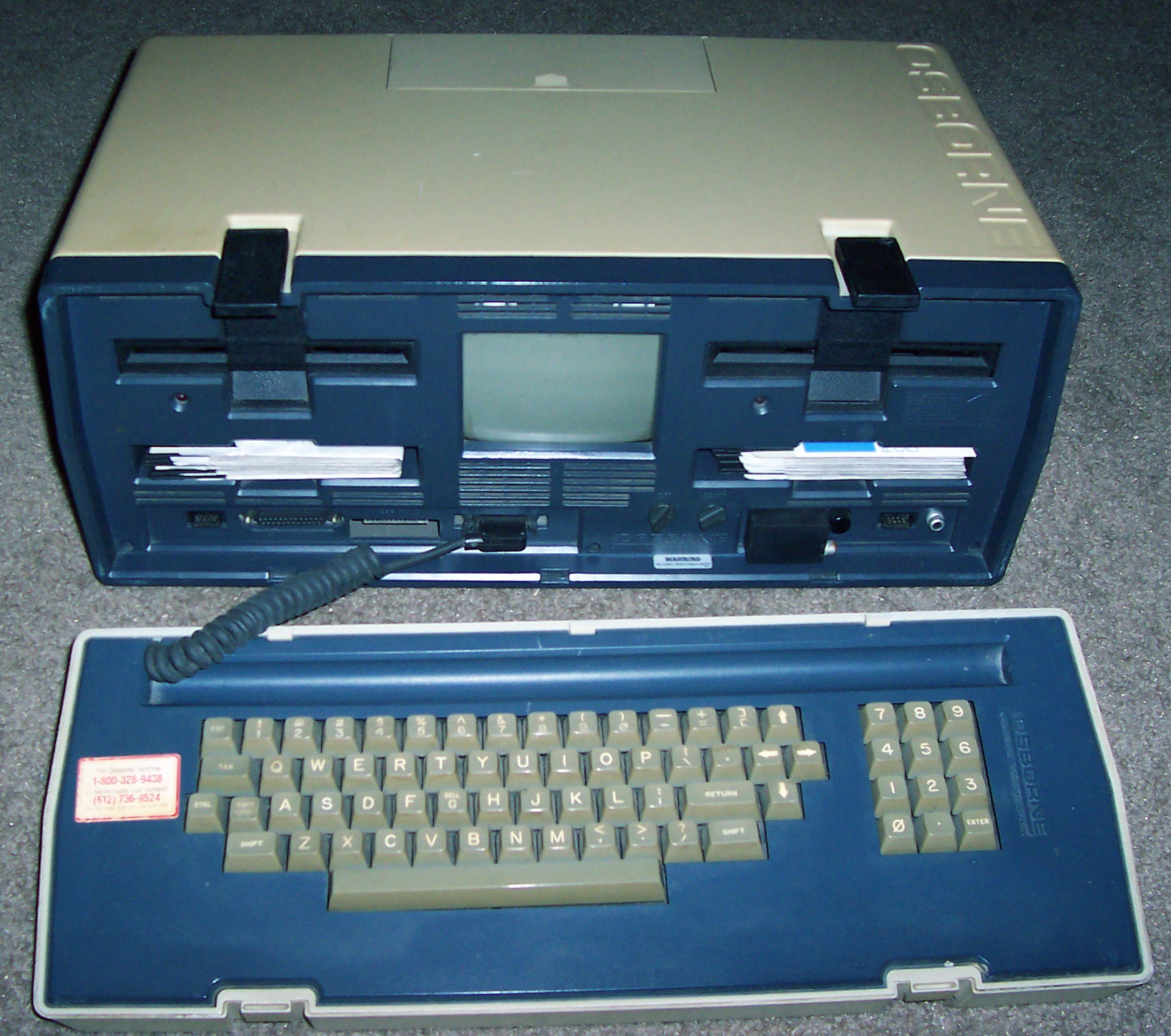
Even though Osborne only expected to sell 10,000 Osborne 1 computers during the entire product lifespan, the Osborne 1 often sold 10,000 units per month!
However, Adam Osborne made one historic mistake in 1983 - he boasted about an upcoming product months before it could be released, killing demand for the Osborne 1. Dealers quickly cancelled orders for the Osborne 1, unsold inventory piled up, and Osborne declared bankruptcy in September 1983. This type of mistake was dubbed “The Osborne Effect” from then on.
Osborne emerged from bankruptcy in the mid 1980s and released the Osborne Vixen, which was pretty much exactly the same as the Osborne 1, but with a larger 7” screen, flip-down keyboard, and smaller case. It didn’t sell well at all, and Osborne faded into the sunset.
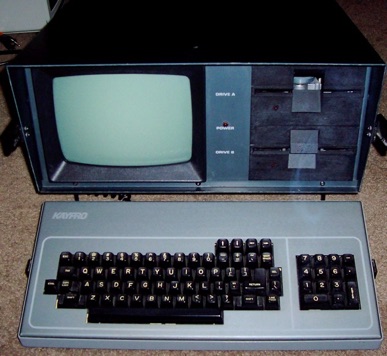
Kaypro
The company that cleaned up the portable marketplace after Osborne was out of the picture was Kaypro. The Kaypro competed fiercely with the Osborne in 1982 and 1983 because it had nearly the same Zilog Z80, CP/M operating system, bundled software, and price, but boasted a much bigger 9” screen.
Like the Osborne, it often sold 10,000 units per month. Arthur C. Clarke wrote the script for 2010: Odyssey 2 on a Kaypro back in 1982.
The only downside to the Kaypro was that looked very clunky and military-like. The case was far less aesthetic than the Osborne 1, and much more difficult to carry. My Kaypro 4 from 1984 has a 4MHz Zilog Z80 CPU, 64KB RAM, and dual 5.25” floppies.
Kaypro lasted into the late 1980s, producing PCs that had the Intel 8088/80286/80386 CPU before fading off into the sunset like most other early PC manufacturers.
GRiD
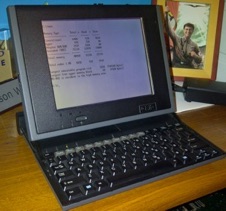
Another rare computer from the 1980s and early 1990s was the GRiD computer. Technically a portable IBM PC clone running MS-DOS (and optionally Windows 3.1), it was probably the most rugged of any PC laptop of the time.
The case was made from magnesium alloy (metal), which made them extremely heavy for their relatively small size. Because of their very high cost (the first model cost more than $8000 US), most GRiD computers were purchased by the U.S. military and NASA (which used them on the Space Shuttle).
Early models used an Intel 8086 CPU and bubble RAM instead of a hard disk, while later models typically used an Intel 80386 CPU, ATA hard drive, and boasted a touch-screen tablet LCD that flipped up to reveal the keyboard as shown in my GRiD 2260 to the right.
SUN Microsystems
SUN (which actually stands for Stanford University Network) is probably the mostly widely known UNIX computer manufacturer. SUN UNIX workstations were everywhere in the 1980s and 1990s, and in 2010, they were purchased by Oracle.
Early SUN computers ran a modified BSD UNIX OS on a 32-bit Motorola 68000 or SPARC/TurboSPARC CPU. However, SUN’s height was in the 1990s, when they switched to high-end UNIX workstations and servers that used 64-bit UltraSPARC CPUs and ran the Solaris UNIX operating system. SUN also introduced us to the notion that “the network is the computer” - most SUN UNIX computers loaded operating systems, applications and data from different areas on the network and stored vital information where it needed to be stored on the network.

Probably the most common SPARC-based SUN computer of the early-mid 1990s was the SPARCstation 5, which had a “pizzabox” form factor and looked similar to an SGI indy (but without the cool case or startup chime).
The one shown to the left was one of the last models produced - it sold in 1996 for $17,000 and had a 32-bit 170MHz TurboSPARC RISC CPU.

By the end of 1996, SUN released its Sun Ultra 1 and Sun Ultra 2 workstations, which had a 200MHz 64-bit UltraSPARC CPU with 1MB of cache that could easily blow away the TurboSPARC. The Ultra 1 had one CPU, while the Ultra 2 had two CPUs. The Ultra 2 was used by Sergey Brin and Larry Page used to run BackRub (the search engine that was later renamed to Google). My Ultra 2 workstation is shown to the right, and with 2GB of RAM, it came with a steep price of $42,000 back in 1996.
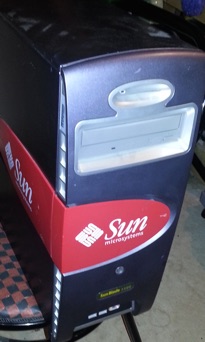
In the late 1990s, SUN had great success in the server market - they released many different models of servers (such as the SUN Enterprise 400) that contained one or more 64-bit UltraSPARC II CPUs. SUN also marketed several UltraSPARC II-based workstation computers (the Ultra 5 and Ultra 10) that used IDE hard drives instead of SCSI, and a standard PC case. The Ultra 5 was a steal at about $8,000 ;-)
In 2001, amid intense competition from PC vendors, SUN came out with several UltraSPARC II-based Sun Blade 100/150 workstations that were very affordable (but cheaply made). The cheapest model with no extras cost only $1000 US, which was amazing for a 64-bit RISC computer at the time (remember that AMD and Intel hadn’t come out with 64-bit computers yet). The only problem? The performance of these workstations was not like previous SUN computers……..to say they were dismal would be kind….
Luckily, SUN stepped up their hardware with the introduction of the Blade 1000 and later workstations that were built with the screaming fast 64-bit UltraSPARC III CPU, and high-end components (including a really nice SUN XVR video card). The picture to the let is my screaming fast SUN Blade 1500 workstation with 8GB RAM running Solaris 10 UNIX.
By the mid-2000s, SUN was struggling to survive in a changing marketplace that saw cheaper high-performance Intel-based servers and workstations. They came out with the UltraSPARC IV (which was basically a dual core UltraSPARC III), as well as a redesigned, low-power, multi-core CPU called the UltraSPARC T1 that was better suited to multi-threaded server applications such as databases. Oracle (a database company) purchased SUN in 2010 and continued to develop both Solaris UNIX as well as servers based on the UltraSPARC T platform until 2017, when they announced they’d be moving forward only with Linux on x86_64.
Tadpole
The 1990s wasn’t just the rise of powerful RISC-based UNIX workstations, it was also the rise of mobile computing. Laptops were all the rage, but the computing power available in 1990s laptops was significantly less than that of their desktop counterparts. Tadpole Computer did what seemed like the impossible at the time: make RISC-based laptops that were more portable and rugged than the average laptop. The only downside? They were ridiculously expensive. But every geek/nerd dreamed of having one.
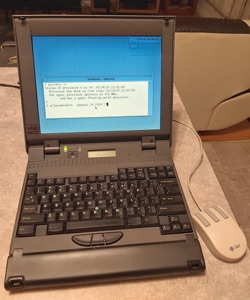
The most popular line of laptops made by Tadpole were the SPARCbook line that had a SPARC CPU and ran SUN Solaris UNIX, but Tadpole also made an ALPHAbook (DEC Alpha CPU running OpenVMS), IBM RS/6000 N40 (PowerPC 601 running IBM AIX UNIX) and P1000 (Pentium running SUSE Linux). These laptops were incredibly thin for the time (even by today’s standards), had amazing graphics, a ThinkPad keyboard (IBM was an investor in Tadpole), and were housed in a rugged magnesium alloy case.
My Tadpole SPARCbook 3000ST from 1997 (shown right) boasted a 170MHz Fujitsu TurboSPARC CPU (the fastest SPARC CPU before everyone moved to the 64-bit UltraSPARC platform) and 128MB of RAM, running SUN Solaris 2.5.1 UNIX at a price tag of $21,000 US. I still play DOOM on it, and use it to give the occasional UNIX presentation because it has VGA output ;-)
Tadpole always had a niche market, and struggled to make sales after 2000 when PC laptops became more powerful and less expensive, and RISC-based UNIX workstations became far less popular. They were eventually bought by General Dynamics in 2005 and faded into the sunset.
Silicon Graphics Inc. (SGI)
My absolute favourite UNIX computer maker of all time is SGI, which was primarily used in the 1990s. SGI concentrated on the graphical side of UNIX - if you had the $$, you could get a powerful SGI computer for scientific modelling, movie making, system administration, etc. The scientific community were their largest client.
SGI primarily used the MIPS processor platform, which was the first 64-bit platform and widely considered to be the most “perfect” RISC architecture. There were many reasons to buy a 64-bit RISC computer in the 1990s: the code you compiled was cleaner and could use more registers as well as use more RAM. Today, SGI no longer supports their IRIX UNIX operating system or the MIPS platform it ran on due to the restructuring they had to do in 2006 to avoid bankruptcy (they were later sold to Rackable Systems in 2009 which uses the SGI brand for their large-scale Intel/AMD-based servers running Linux). This is one of the tragedies of the IT industry - IRIX/MIPS was an amazing platform that was used to do so many great things in history. Now SGI sells large systems running Intel/AMD and Linux to companies. Rest in peace.

To the left is a picture of my sexy blue Silicon Graphics Indy with a 64-bit R5000 180MHz MIPS RISC processor (very powerful for the time in 1996) and a Silicon Graphics web-cam.
It also had a weird floptical drive (Infrared-guided floppy that stored 21MB of data). I must also mention that it had the coolest sounding startup chime (almost like the beginning of a news report). The price tag: only $15,000.
The Indy was SGI’s low end machine of the time - its big brother was the Indigo and the Indigo2 which either ran the 64-bit R4400 or R10000 MIPS RISC processor, but also came at a much higher cost (only high-end graphics studios could afford the Indigos at the time).
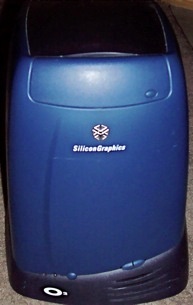
In the mid-late 1990s, SGI came out with two far better computers - the lower end SGI O2 (and later SGI O2+) that boasted a 64-bit R5000/7000 or ultra-powerful R10000/12000 MIPS CPU, and the high-end SGI Octane (and later SGI Octane 2) running a 64-bit R10000/R12000/R14000 MIPS CPU.
SGI made sure their computers looked cool too! You may have seen Erwin, the SGI O2 computer in the UserFriendly comic strip at http://www.userfriendly.org. It has a small form-factor, which makes it “cute”, yet is quite powerful enough to handle IRIX and a plethora of applications without choking. I still have three SGI O2 computers - the one shown to the right has a 195MHz R10000 CPU and originally cost $14,000.
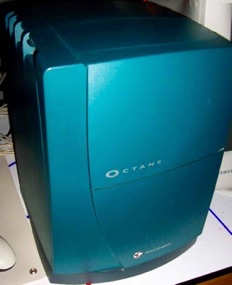
The SGI Octane wasn’t as “cute” as the SGI O2 - instead, it was much bigger, much heavier, and sported a much more powerful video card.
I also have three SGI Octane computers.- The one shown left has two 200MHz R10000 CPUs at a cost of $39,000!
If you wanted the best graphics, you bought an Octane with the high-end Odyssey video card, but they had a 750W power supply, very heavy metal chassis and hard drive bay enclosure, and sounded like an air conditioner when powered up. The system didn’t have a front-side bus - instead all components talked directly to each other via a component router (much like the HyperTransport from AMD).
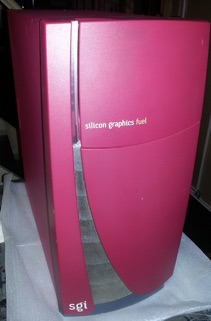
The SGI O2 and Octane remained SGI’s most popular computers (and the desire of many IT geeks) during the late 1990s, and SGI followed them up with far more powerful computers in the early 2000s: the SGI Fuel and SGI Tezro. The SGI Fuel had a single 64-bit R14000/R16000 MIPS CPU, and the SGI Tezro had four. My SGI Fuel (shown to the right) has a 600MHz R14000 MIPS CPU and the ultra high-end Odyssey V12 graphics card. While it can still outperform the average PC today when it comes to visual effects in Blender, it was hard to justify its high cost back in 2006 ($16,000) compared to other high-end PCs of the time, and relatively few were sold compared to the SGI O2 and Octane. In short, SGI’s company sales nose-dived in the early 2000s and the company was forced to ditch IRIX and the MIPS platform as a result.
Remember that IRIX was commonly used for graphics computing such as chemical modeling and making effects for movies. In fact, several even made their way into movies! In the movie Jurassic Park (1993) when the girl (Lex) sat down at the computer near the end to activate the locks and said “This is UNIX, I know this…”, she was actually using the File System Navigator (fsn) in IRIX to navigate the /usr directory.
Below is a picture of the File System Navigator that looks shockingly similar to the movie.
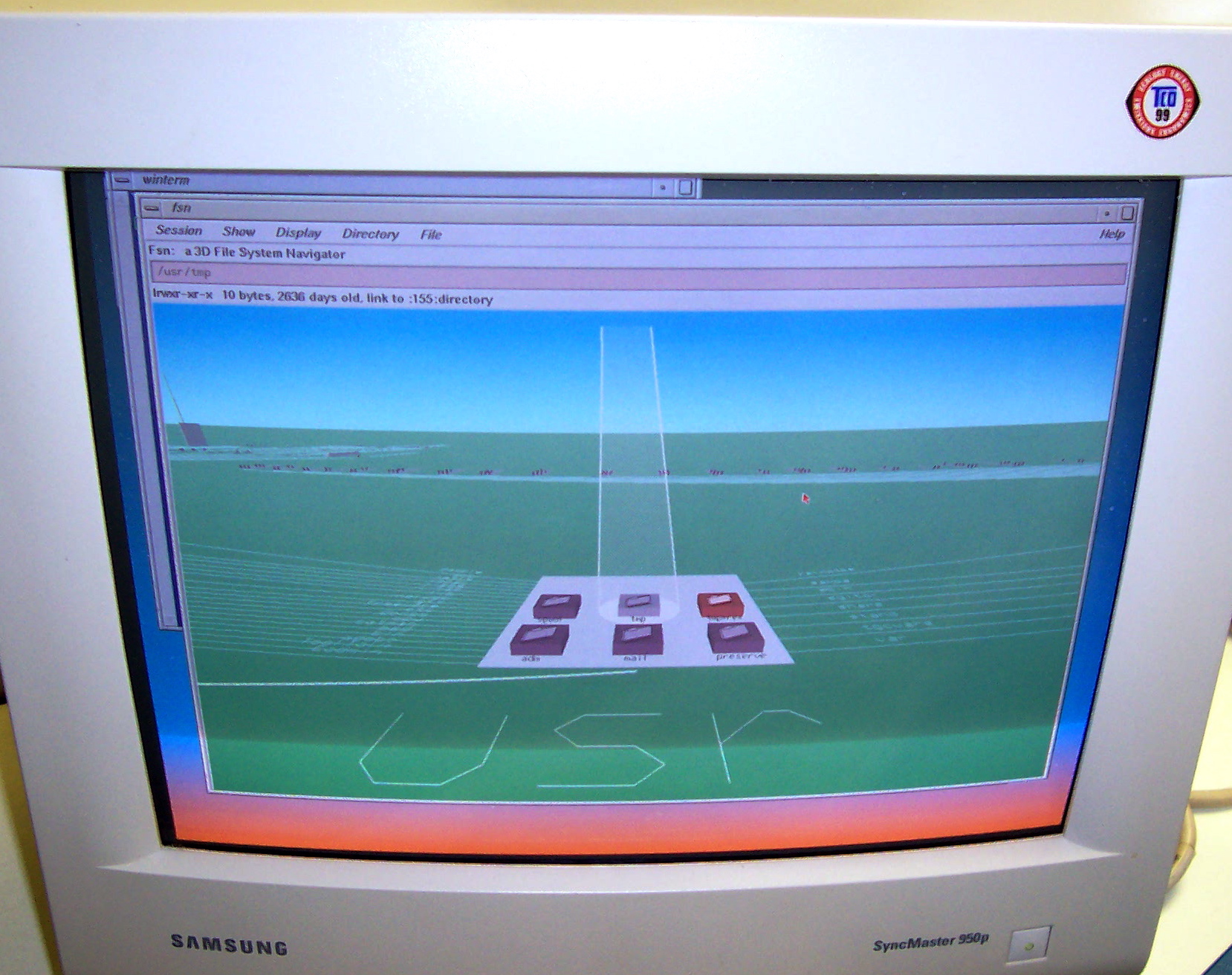
Digital Equipment Corporation (DEC)
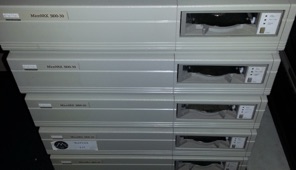
DEC is a legend. They pioneered much of computer science in the 1960s and 1970s with their 16-bit PDP (Programmed Data Processor) computers which influenced the design of all other computer architectures. In the late 1970s, they introduced a 32-bit computer called the VAX (Virtual Address eXtension) that was used until the early 1990s. It ran the VMS or UNIX operating system, and was very popular in science and engineering companies as well as universities.
To the right are 5 MicroVAX 3100/30s that are clustered together to perform as a single unit. Each one cost $21,000, and had a 25MHz CVAX CPU…..which was only a bit more powerful than typical 32-bit PC CPUs of the time. As a result, DEC’s sales dipped dramatically in the early 1990s until the introduction of the DEC Alpha.
The DEC Alpha could easily blow away any other UNIX box for raw computing power, but it cost a small fortune. The DEC Alpha CPU was an incredibly powerful 64-bit RISC CPU, and the most powerful CPU of the 1990s.

The Digital Ultimate Workstation (also called the AlphaServer 1200) shown to the left cost $82,000 in 1997 and has 2, 533MHz 64-bit Alpha 21164 (EV56) RISC processors (EV stands for “extended VAX” since the Alpha integrated many VAX functions). It can run True64 UNIX, VMS, Linux or Windows NT4/2000. This made Alphas ideal for large-end tasks such as computational research, modelling, and movie rendering. In fact, this Digital Ultimate Workstation was used by a company called Digital Domain when creating the graphics for the movie Titanic in 1997 (they used SUSE Linux as their OS).

DEC also released the single-CPU Digital Personal Workstation (often called by its codename “Miata”). My Digital Personal Workstation with a 600MHz 64-bit Alpha 21164 (EV56) RISC CPU is shown to the right, and had an original price tag of $26,500 (but well worth it!).
Compaq bought DEC in 1998 and continued marketing the Alpha. When HP bought Compaq in 2001, they continued to sell Alpha servers to existing customers until 2006. Intel now owns the rights to the Alpha platform (purchased from Compaq), and have used parts of the Alpha technology in their new Core 2 Duo and later chips (they saved billions on R&D in their competition with AMD). In June 2016, the fastest supercomputer in the world (the Chinese Sunway TaihuLight) used CPUs based on the same 21164s that were used in the Digital Ultimate Workstation and Digital Personal Workstation shown above!
NeXT

NeXT was a small treasure in the UNIX world in the late 1980s and first half of the 1990s. It was the brainchild of Steve Jobs (co-founder of Apple) after he got kicked out of Apple. They made UNIX workstations based on the Motorola 68040 CPU (the first model used the older 68030). NeXT workstations weren’t that popular - but their real claim to fame was in their software. They used a BSD UNIX flavour with a MACH kernel called NeXTSTEP.
NeXTSTEP was by far the easiest, prettiest and most intuitive UNIX to use, and had the most amazing object-oriented software development tools (Objective-C + several frameworks).
Universities and science/engineering companies that didn’t buy NeXT computers bought NeXTSTEP for development since NeXT also released NeXTSTEP for the Intel x86, SPARC and PA-RISC platforms. And when Steve Jobs returned to Apple in 1997, he brought NeXT with him, and NeXTSTEP became Macintosh OS X (with very little modification) and later iOS. If you’ve ever developed an app for Mac or iOS, you’ll know that the parent object that everything inherits from in Objective-C is NSObject (which stands for NeXT Software Object).
The ease of development on NeXTSTEP also led to another key part of computer history - the invention of the Web! Tim Berners-Lee used a NeXT workstation at CERN to create the world’s first Web server to showcase his new protocol called HTTP and framework called the World Wide Web (WWW)!
Shown to the right is my NeXTStation Turbo workstation with a 32-bit 33MHz Motorola 68040 CPU (the fastest CPU NeXT released) and greyscale graphics (no colour!). The base price was $6500 in 1990 (much more if you added more RAM - it could support up to 128MB).
Hewlett-Packard (HP)
You are probably thinking: Why did Jason include HP here? They’re nothing special….just a PC manufacturer. Well, that is partially correct. But in the mid 1990s, HP made a series of high-end UNIX workstations with PA-RISC (Palo Alto RISC) CPUs that were much cheaper than a similar Sun, SGI or DEC computer. They shipped with HP-UX UNIX, but a lot of companies installed NeXTSTEP UNIX on them (see above).

Shown to the right is my HP PA-RISC 712 workstation with a 32-bit 80MHz PA-RISC CPU. It cost $8500 in 1994 and contained a foam chassis inside that held the hard drives (I was always worried that the foam would get too hot and start on fire, but it never did). And yes, it is currently running NeXTSTEP.
Burroughs/Unisys ICON
![]()
This is probably the coolest looking but most obscure of all the UNIX workstations I have. It was a computer designed by the Ontario government and manufactured by Burroughs (later renamed Unisys) for use in schools in the 1980s.
It had 512 KB of RAM and a 7.16 MHz 80186 CPU, but no local storage. Instead, the QNX UNIX operating system derivative it ran was netbooted from a LEXICON file server in the classroom over a coaxial ARCNET network. The picture here shows QNX netbooted on the ICON from the LEXICON file server (which I also have, but not shown).
For the time, this was a brilliant design as new software added to the LEXICON was made available to the entire class. Moreover, all user files were stored centrally on the LEXICON hard disk, as were shared peripherals (printers, modems, etc.). But the cost of each ICON was $2500 ($500 after a government subsidy), so it wasn’t cost competitive to PCs by the late 1980s that had a much bigger software library. Consequently, it was widely seen a massive waste of government money. By 1994, the ICON project was formally discontinued and the government ordered all ICON hardware and software to be sent to landfill (luckily this one survived the purge).